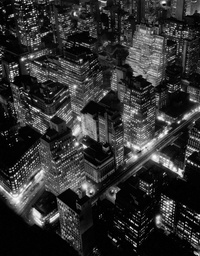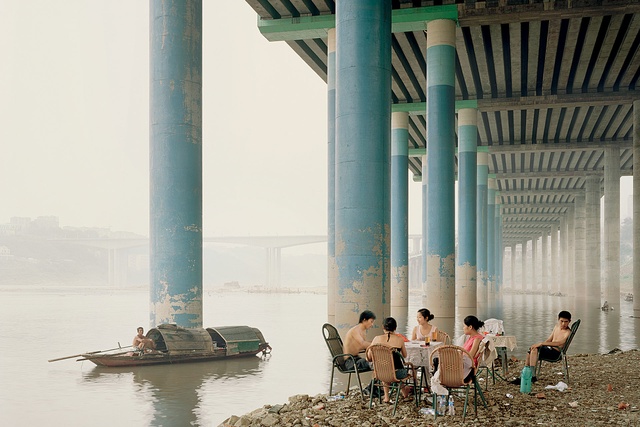Architecture under the shutter

“My wife used to say: ‘After all, it’s only a glass box with two girls in it’. But somehow that one scene expresses what architecture is all about,” observed Julius Shulman of an iconic photograph of Case Study House #22 (1960).
Berenice Abbott photographed Night View, New York (1932) from the top of the Empire State Building on a late, mid-winter afternoon, before office workers switched off their lights and left, with a single, 15-minute exposure. Shulman exposed the distant Los Angeles lights for seven minutes, before switching on interior lights, replaced with flash bulbs, to capture his dramatic nocturnal image of the house.

Constructing Worlds: Photography and Architecture in the Modern Age exhibits works by 18 photographers, geographically spread across Africa, America, China, India and Europe. Although the works are exhibited chronologically, themes and interests intersect and connect photographers across different generations. Their diverse aesthetic approaches encompass the documentary realism of Walker Evans and Iwan Baan, the conceptualism of Ed Ruscha and Bernd and Hilla Becher, and photography commissioned from Lucien Hervé and Hélène Binet.
Le Corbusier collaborated with Hervé in documenting Chandigarh over two decades, describing him as having ‘the soul of an architect’.

Evans’ documentary style influenced contemporary photographer Stephen Shore’s unsentimental street scenes and Thomas Struth’s contemporary colour photography, in addition to Ruscha’s photobooks documenting the banality of 20th-century LA and archival photographs of decaying, arcane European industrial archetypes, documented by the Bechers.
The concrete brutalism of the Barbican Gallery is challenging for exhibition designers, but was overcome skilfully by the Belgian architectural practice OFFICE KGDVS. These designers reduced the monotony of the upper enfilade of open bays, where the exhibition begins, by varying the palette of wall colours from cool, pale grey to warm charcoal. Where the exhibition continues on the lower level, they broke up an unsympathetic hangar-like space by creating partitioned areas in a variety of simple geometric shapes: triangular, circular, pentagonal and square. These focus attention on displays of photographs by Hiroshi Sugimoto, Luigi Ghirri, Hélène Binet and Luisa Lambri respectively, which might have been overwhelmed in larger spaces.
Photographs of cities undergoing dramatic changes, by Guy Tillim, Andreas Gursky and Bas Princen, share a vast rectangular room on the lower level, with a monumental square concrete pillar at its centre. “We made an architectonic feature out of a necessity,’ comments David Van Severen of OFFICE KGDVS. Photographs by Simon Norfolk reveal past scars in present architecture; Nadav Kander’s monumental images of contemporary construction in China are impressive; and Baan’s Torre David series documents squatters’ redemptive transformation of a 45-storeyed building in Caracas, abandoned after the economic crash.

Elias Redstone, co-curator of the touring exhibition, has been burning the candle at both ends. As well as co-editing its excellent catalogue, Constructing Worlds: Photography and Architecture in the Modern Age (Prestel; 2014), he has written another book covering similar territory, Shooting Space: Architecture in Contemporary Photography (Phaidon Press; 2014). Both volumes are well-illustrated, thought-provoking additions to the literature of historical and contemporary architectural photography.









